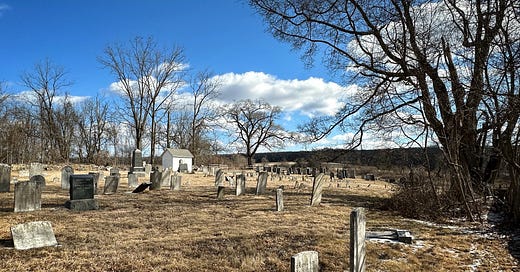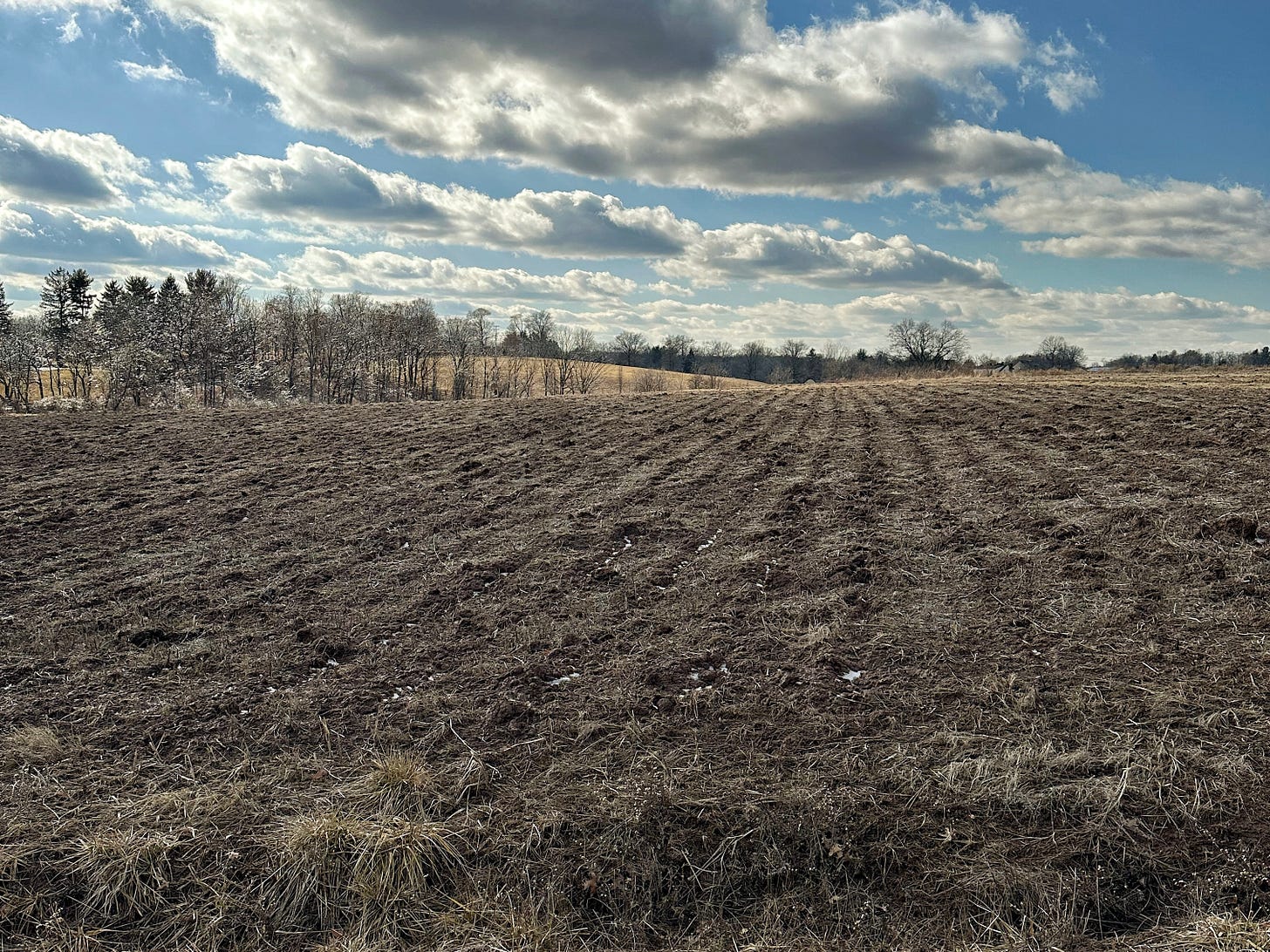Sunday Pastries With the Dead 45
The 1725-era Stout-Manners Cemetery in Ringoes, NJ.
Today’s tiny cemetery was a bit of a bait and switch. In my pre-research, photos from this family burial ground-turned-small town graveyard appeared to show several Colonial-era stones with beautiful soul effigy carvings. On an unexpectedly free afternoon, I took a long drive down several gorgeous rolling hill and farm-flanked back roads to visit them.
What I found, instead, was a sadly common sight: rows of weathered, broken slate and sandstone markers like so many sharp teeth jutting from the frozen ground. The images I’d seen online were clearly not recent—a sobering reminder that taking photographs of headstones isn’t just a hobby, but an archival pursuit. The elements have their way with these centuries-old beauties, under even the best circumstances—most burial grounds (especially small ones) don’t have well-funded maintenance and restoration teams, and the markers too easily fall into disrepair.
But, lucky for me, there was a delightful switch to accompany the bait: a number of truly lovely 18th-century stones made by local carvers. As I’ve mentioned before, folks in rural areas often didn’t have the funds for or access to professional carvers who worked in larger towns and cities (headstones were heavy—they required transportation via waterways and established roads), so the task fell to relatively inexperienced local carpenters and farmers who needed work in the off (aka: winter) season.
These stones are some of my favorites to find—they’re whimsical in their imperfections, with wobbly lettering and visible rule lines that stand as an enduring testament to the labor-intensive and tough-to-master carving process. They don’t have intricate designs on the tympanums or evenly-spaced and crisply-cornered letters, and they often only sport the deceased’s initials in a shallow, unpracticed carving method. In short: they’re easy (and delightful!) to spot.
Before I show you the goods, I want to expound on something mentioned above: the prohibitive price of headstones. A grave marker could easily cost a year’s salary for a working-class person in the 1700s and 1800s. So, beyond what we investigate from non-professional carvers (who still charged more than many could afford), it’s important to understand that headstone history is middle and upper-class white history. Slaves, indigenous people, prisoners, hospital patients, the mentally ill, and the poor were buried without markers, or—at most—beneath a pile of flagstones. It’s key to view these graveyard explorations from this angle—we aren’t analyzing an accurate demographic of the people from a time based on the monuments left behind, we’re analyzing the ebbs and flows of an area’s wealth.
Stepping down from my soapbox now to move on to the main event—with the teased sub-headline pirate story at the end, for good measure! This little cemetery contains only about 300 burials, and it began as a family graveyard for several local founding residents. Over time, neighbors were welcomed into the fold, and it remains an operational cemetery for the current New Jersey township. Its official year of establishment is 1872, but the oldest recorded burial here is 1725, so that’s what we’ll go with instead. As you’ll see, thanks to lettering style, we’re able to trace the work of several different amateur local carvers here.
Amos Stout’s 1763 stone (above left) is one of the oldest remaining, and—unsurprisingly—is barely legible. You can just about make out the year and APR, signifying his death month of April.
Levi Stout’s name is still quite fresh on his stone (above middle), and you can almost see the year of his death—1772—at the bottom. Thanks to old photos, I know the middle section reads DS (deceased) nove, so he died in November. Based on the shape of the U’s and e’s, I think these two stones are by different carvers. Amos’ lettering also has a bit more depth, while Levi’s is quite shallow (though without rule lines!)
And this 1776 E. Servis stone (above right) is definitely by the same carver as Levi’s—look at those angled S’s! What a difference four years makes…
Rachel Stout’s (above left) local carver looks to have some good experience—the lettering is impressively even, and includes serif font flourishes in spots. She died in 1787, and we see the abbreviation of the words deceased (dc), August (au), the (ye—this is a holdover from Old English), and year (yr). Headstones were charged by the letter, which is why you’ll often see words shortened. Worse than the erosion at the top of Rachel’s stone is that the bottom of the slate slab sports some gnarly slices of lawnmower damage (another depressingly common sight; tightly-packed monuments are tough for groundskeepers to navigate around).
Sarah Stout Sharp’s 1790 headstone (above right) seems to be from the same carver—see the shape of the lowercase e and the hard angle of the lower swoop in the u’s? The FABRU means she died in February.
Moses Stout’s 1791 stone (above left) may also be by the same person—see how the lines are getting a bit deeper, with more curvature? The carver is becoming more confident! The OC means he died in October.
And just two years later, our carver may’ve gotten a bit ahead of himself—see how he almost missed a letter in the death month on Mary Stout’s 1793 stone (above right)? He probably retroactively realized MA could stand for May or March, so he hastily added that tiny R. I also have to chuckle at his incongruous use of both capital and lowercase letters, which makes her first name appear to be Maty at initial glance. Perhaps he wasn’t particularly enamored with carving uppercase Rs.
It’s hard to tell with the weathering, but I think—based on the very square letters, the un-angled S’s, and the particularly triangular A’s—that Moses Labaw’s April 1794 stone is made by a different carver than we’ve seen thus far. The technique is fairly good—depth, serif—so it wouldn’t be an apprentice. The e’s and s’s look similar to Moses and Mary’s stones, but it entirely lacks the flourish and confidence of that carver. Maybe someone attempting to copy his style?
D.L.’s stone is a prime example of a family only being able to afford initials—the death date and month are long gone, but the fully-spelled “deceased” remains (with the s’s flipped—the mark of a carver we haven’t yet seen!) I also appreciate that the first dot between the D and L is circular; whether on purpose or not, it feels like a design element.
*Drumroll* and now, for the pirate tale! Just 10 minutes from this cemetery is a lone obelisk monument semi-hidden in the brush at the border of a large working farm. It was erected in 1932 by the town for which its interred founder—John Ringo II—is named. You can see a small piece of an original slate headstone jutting out in front of the marble marker; several of Ringo’s family members are also buried here, so it’s anyone’s guess who it belongs to.
Ringo ran a popular local tavern during the American Revolution before dying suddenly at age 44 in 1779. His father, Philip Ringo, is the nephew of the aforementioned legend-maker, John Ringo I, who was born in 1655 near Philadelphia, and later moved to New Amsterdam (now New York City) and became a sailor.
As the story goes, John’s ship was attacked by pirates while docked at a port on the Spanish Coast; John was abducted and brought aboard their boat. He eventually escaped by stealing the vessel while the pirates were off board, and he sold all the cargo in NYC—save one chest, which he later found to be filled with gold. Knowing that this was blood money, he refused to use it—instead, he fled NYC and buried it deep in the wilds of New Jersey on his family’s property. He did so without telling anyone the location, to honor the memories of those it was stolen from. Could it be that it’s still hidden beneath the earth of this farmland, alongside where John II and the rest of his ancestors are interred?
That’s all for this latest cemetery visit—thanks for joining me! If you love these posts and want to help fund my research and reporting, you can upgrade to an optional paid subscription by clicking the button below. Until a future Sunday, fellow taphophiles!












